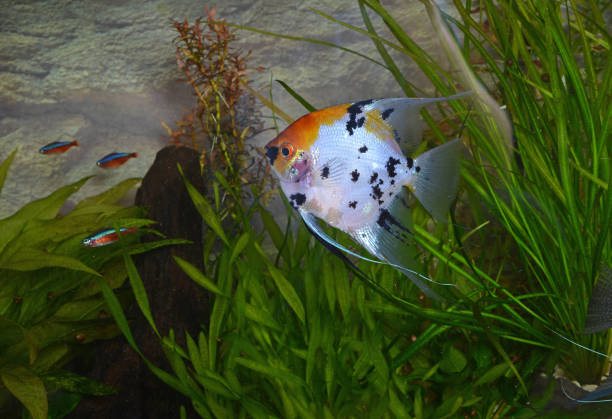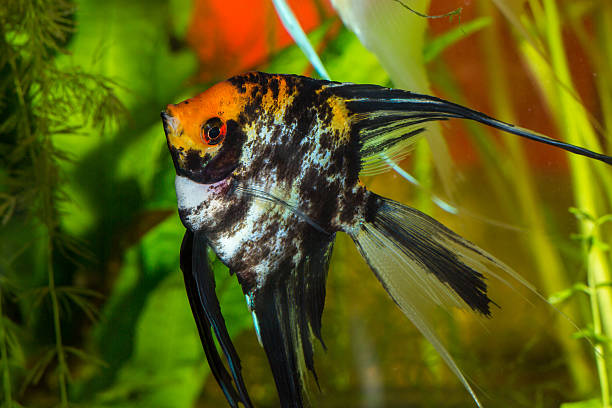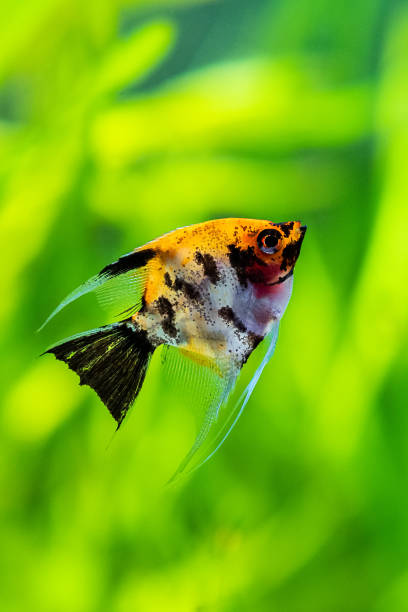Your ultimate answer on care tips and the best breeding conditions for the mixed-breed Koi Angelfish — aesthetically pleasing and easy to maintain.

Introduction to Koi Angelfish
Every fishkeeper knows that ornamental fish species are the go-to when looking to spice up your indoor or outdoor aquarium. Now, if you’re searching for a unique species, I have just the right pick for your tank — the Koi Angelfish.
This colorful aquarium fish is what you get when you breed the Japanese Koi fish with the elegant Angelfish. Although it’s not one of the most popular angelfish varieties, I promise you the Koi Angelfish is worth adding to your collection.
Not only is this variant attractive, but it’s also easy to care for whether you’re an expert or a beginner aquarium enthusiast. This complete guide tells you all the necessary information about keeping this species, so I formally welcome you to the colorful world of Koi Angelfish!
History and Origins
A brief insight into the origins of the Koi angelfish will prepare you for the journey ahead. Like most ornamental Angelfish, the Koi is a product of selective breeding towards the end of the 1900s.
The Koi’s discovery is also part of the aquarium trade history, where ornamental fish traders sought new colorations to boost their businesses by promoting exclusivity.
With each new breeding experiment, there was a boost in angelfish development, and today, it’s become one of the most colorful decorative species in all aquariums. Now, let me show you the result of breeding Japanese Koi with Angelfish.
Physical Characteristics

The Koi Angelfish’s appearance is triangular, with a lateral body and long fins. At full maturity, this species grows up to 6-8 inches in body length, while its fin structure varies depending on genes and other conditions.
But those aren’t its most striking physical characteristics.
Koi Angelfish stand out because of their bright orange and white coloration with patches of black and yellow in varying patterns, like the Japanese Koi.
If you want to keep its vibrant fish coloration, you must follow certain care requirements. These needs are because of its ornamental fish traits such as scale color and long fins.
Care Requirements for Koi Angelfish
I know I said Koi Angelfish care is simple, but that also makes it easy to fumble. If you don’t want to stumble through your first freshwater fish care as a beginner or even an experienced aquarist, here’s what to do —
- Provide optimal water conditions for your Koi Angelfish
- Practice systematic and periodic tank maintenance
These two things play a primary role in ensuring your pets maintain their vibrancy physically and mentally. So, how can you achieve the perfect tank setup?
Ideal Tank Setup for Koi Angelfish
A single Koi Angelfish grows up to 6 – 8 inches and has a lateral triangular body, so it needs a tank that accommodates its physical characteristics. Here are the perfect conditions for an ideal tank setup.
Tank Size
Get a tall tank that contains about 20 – 30 gallons of water for a personal aquarium holding a small group of Koi Angelfish. However, for a larger group, a multi-species community, or a public aquarium, make the tank atleast 55 – 75 gallons.
Water Parameters
As freshwater fish, the ideal tank conditions for your Koi Angelfish include slightly acidic water with pH levels 6.8 – 7.8, cool temperatures between 76-82℉, and a hardness range of 5 – 20 dGH.
Always change 20 – 30% of the tank water bi-weekly or at least once a month, depending on the tank size and waste production. You can aid the nitrogen cycle and boost waste management by adding a standard filtration system. It’ll also help you maintain the water quality.
Decoration & Substrate

When decorating your Koi Angelfish aquarium, always reference its home. Remember that the Angelfish is from tropical South America, so whether artificial or real, plants are always a good choice.
Be careful not to sacrifice safety for beautiful decorations.
Add smooth-edge rocks, granites, sand, and driftwood as good hiding spots. Avoid any decor that can easily move or hurt your pets’ delicate fins and scales.
And there you have it, the perfect aquarium design for Koi Angelfish. Now, let’s talk about food.
Feeding and Diet
When it comes to your Koi Angelfish diet, you have it easy because they’re omnivores. They’ll eat plants and live food alike. You can take the simple route of feeding your pets with commercial fish food like flakes and pellets.
But if you want a diet for vibrant fish coloration and the best overall health, I recommend balancing all classes of nutritious fish food. Some options you can try are bloodworms, brine shrimp, daphnia, blanched zucchini, peeled peas, and spinach.
Vegetables are good for the digestive system and gut health, while proteins, vitamins, and minerals help maintain their bright coloration.
Not too fast. We still haven’t addressed your Koi Angelfish’s feeding habits. Or did you think they could eat as much as they liked? Because then, you’d be wrong.
Feed your adult Koi Angelfish between 2 – 3 times daily and only in portions they can finish within 2 minutes. You can increase the feeding to 3 – 4 times daily for growing Koi Angelfish. There’ll be more on this later, but first, let me explain why portion control is important.
Overfeeding can lead to health complications like obesity or bacterial infections from water pollution caused by excess waste. This excess waste could be poop or pee from your Koi Angelfish or degenerated food that turns into ammonia and doesn’t complete the nitrogen cycle.
For more on feeding your aquatic pets check out The Ultimate Guide to Fish Food: Pros and Cons & Best Choices!
Health and Common Diseases

I just hinted at overfeeding being the biggest threat to your Koi Angelfish’s health, but there’s more. This species is also prone to common fish ailments like Ich, Fin Rot, and Dropsy, while it also is at risk of other ornamental fish diseases like Velvet.
Here’s a closer look at each ailment, its causes, symptoms, treatment, and prevention.
Ich (White Spot)
Cause: Parasitic Infection
Symptoms: White cottony spots on fins and skin
Treatment: Copper-based meds and increased water temperature to kill the parasite
For more details checkout our article on How to Treat Ich Outbreaks in Your Freshwater Fish!
Fin Rot
Cause: Poor Water Quality, Bacterial Infection
Symptoms: Fraying and damaged fins, Discoloration
Treatment: Antibiotics, Water Change
Dropsy
Cause: Internal organs deteriorating because of internal bacteria, Poor Water Quality
Symptoms: Bloating, Raised Scales
Treatment: Water Change, Veterinarian visit for diagnosis and medication
Velvet
Cause: Protozoan infection
Symptoms: Dusty skin, Discoloration
Treatment: Copper-based medication, Water Change
Maintaining water quality helps with fish disease prevention because it ensures zero bacteria or fungus growths, which are the leading causes of most ailments. Also, sick fish should be quarantined to prevent the spread of their diseases if they are contagious.
That’s saying your aquatic health care starts from fulfilling all your pet’s basic needs, from dieting to living conditions. However, these needs vary when it comes to caring for young and new Koi Angelfish.
Breeding Koi Angelfish
When breeding Koi Angelfish, you need a separate tank setup because the water conditions are different. If you’re ready for Angelfish reproduction, then follow these breeding tips.
Breeding Tank
Get a tall tank that holds 20 gallons for one pair of adult Koi Angelfish. Add a sponge filter to the tank with a flat surface for laying the eggs and a hiding spot for spawning.
This video has been very helpful in identifying the sex of angelfish, I highly recommend it:
Water Conditions
Maintain the pH level and hardiness but increase the water temperature to 78-84℉ because the female Koi Angelfish need warmer waters to encourage her body to breed.
Spawning
When it’s time for mating, the male Koi Angelfish will chase the female to her hiding spot and nudge her belly to spawn her eggs on the flat surface. She’ll lay multiple eggs at once, and the male will fertilize them on a flat surface.
Fry Care
Within 3 – 4 days of fertilization, the Koi Angelfish eggs will hatch. Their first meal in the real world will be their yolk sacs, after which you must feed them infusoria. By the sixth to eighth day, they’ll start growing larger and free swimming.
At this stage, change their diet to crushed pellets or flakes specially made for fish fry. When they get bigger, they should introduce live food like crushed brine shrimp to their diet.
If you follow these fry-rearing tips, I can guarantee you a healthy Koi Angelfish breeding tank. After successful fish breeding, it’s time to reintroduce your pets to the main tank.
Behavior and Compatibility
Although you know the Koi angelfish’s behavior is social and graceful, I must warn you that this species gets territorial. They’re most territorial during breeding and feeding, which is why they need separate breeding tanks and prefer to move with groups of the same species.
That doesn’t mean you can’t add your Koi Angelfish to a community tank. If you want to maintain peaceful fish communities with this species, then follow these aquarium fish compatibility rules:
- Pair them with medium sized freshwater fish like Corydoras and Tetras
- Keep your Koi Angelfish with peaceful species
- Avoid pairing them with smaller fish to prevent predation
Following these rules guarantees your Koi Angelfish’s social behavior will always be amiable, and if it’s not, that could be a sign of health complications.
Conclusion
Today, I’m parting with simple instructions: Pay attention to your pets because no amount of fish-keeping tips will protect them from neglect. But if you observe your Koi Angelfish daily, you can easily note alarms based on overall ornamental fish care.
So, let’s do a quick Koi Angelfish care overview of what you should observe during your daily check-up:
- Optimal Water Condition
- Feeding and Diet
- Physical Characteristics
- Health Condition based on Social behaviors.
You’re ready to set up your Koi Angelfish aquarium!


